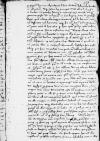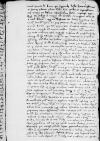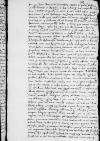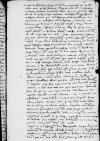Quod te vivum esse mihi Deo gratia vivo declarasti, incredibili gaudio me affecisti gestiensque non sine summa voluptate copiosas tuas ⌊⌋ adeoque amanter ad me scriptas legi et relegi non semel et, cum eas ⌊magistratus Gdanensis⌋ per certum ad me nuntium misit, nolui illum sine meis hinc dimittere, quas dominis suis daturus est, ut illi, quo ad te perferantur, modis, quibus possint, curent commodioribus. Dabis igitur, si brevior aut incultior fuero, amico veniam. ⌊⌋ hinc paulo ante ⌊reverendissimo domino Lundensi⌋ petens ab eo, ut si quid de te rebusque tuis sciret, me redderet certiorem, quandoquidem, quod tanto a te tempore nullas acceperim, dubium me de salute tua non parum fecit, scio etenim, quam diligens et officiosus scribendo aliis amicis esse soleas, de quorum numero tibi me non ultimum esse certe mihi persuadeo. Existimo sane, quod et in me experior, inter amicos usu venire, ut cum vel raro sese videant, aut invicem aliquamdiu non scribant, alicuius magni infortunii sive mortis subnasci opinionem, utpote, quod in ea cessatione amicorum animos non nisi res durissima vel casus quispiam fatalis inducere potest. Quo factum reor, ut, cum de me interdum ob temporum incommoditates vel tam vastam locorum intercapedinem nihil auditur seu scribitur, {quod} toties desideratus dicar. Hocque tandem aliquando fiet – mortales sumus – quo tempore Deus nos vocaverit, neque id mirum erit,
cf. Sen. Apoc. 3.4 ‘Hos’ inquit ‘tres uno anno exiguis intervallis temporum divisos mori iubebo, nec illum incomitatum dimittam. Non oportet enim eum, qui modo se tot milia hominum sequentia videbat, tot praecedentia, tot circumfusa, subito solum destitui.
; Sen. Ep. 54.5 In hoc enim, mi Lucili, nisi fallor, erramus, quod mortem iudicamus sequi, cum illa et praecesserit et secutura sit. Quidquid ante nos fuit mors est. ⌊multi nos, ut ⌊Seneca⌋ inquit, praecesserunt, multi nos sequentur, nec primi nec ultimicf. Sen. Apoc. 3.4 ‘Hos’ inquit ‘tres uno anno exiguis intervallis temporum divisos mori iubebo, nec illum incomitatum dimittam. Non oportet enim eum, qui modo se tot milia hominum sequentia videbat, tot praecedentia, tot circumfusa, subito solum destitui.
; Sen. Ep. 54.5 In hoc enim, mi Lucili, nisi fallor, erramus, quod mortem iudicamus sequi, cum illa et praecesserit et secutura sit. Quidquid ante nos fuit mors est. ⌋
,
modo sic vivamus, ut cf. Vulg. Lc 12:37-40 ⌊quacumque noctis vigilia Dominus venerit, parati simuscf. Vulg. Lc 12:37-40 ⌋. Atqui revera de te, cum tanto tempore non scriberes, triste quippiam, de te, inquam, subverebar, ut qui et aegrum te maleque ex tot itineribus affectum rediisse fama acceperam. Et qua sollicitudine, superatis iterum, ut scribis, tot periculis, me tuae litterae solverunt, quibus ad praesens carptim respondendum duxi, opportuniori tempore de omnibus copiosius.
Quod morem mihi gesseris relictis turgidis illis appellationibus seu titulis, quibus plerique nostro aevo gloriosiores sibi placent, meque nudis et amore nostro mutuo convenientibus verbis scribendo conveneris, gratissimum mihi fecisti utque hoc pacto mecum agas semper, a te pro iure nostrae amicitiae postulo. Ceterum et excusationem tuam, quod ⌊⌋ anni
praeteriti praeter ⌊⌋, quas heri accepi, nullas ad me dederis, libenter admitto. Non tam me angit litterarum tuarum desiderium, quam ut te sciam esse superstitem, qua in re tua olim mathesis,[1] quae breviorem tibi vitam polliceri videbatur, non parum interdum me turbat, verum Deo fidendum est, qui omnium rerum posuit fines et terminos, quos antevertere et praevenire nemo potest. Illius benignitatem una tecum laudo et extollo, quod vivimus vivemusque, quamdiu illa permiserit in hac temporaria hic nostra amicitia, et deinde, ut speratur, in illa aeterna, cum omnibus sanctis spiritibus communi perpetuo.
Quod scribis serenissimam ⌊Hungariae reginam⌋ cum sorore ⌊Leonora⌋ in ⌊oris Gallorum⌋ convenisse, prius accepi, additum tamen fuit ⌊regem Galliae⌋ sub praetextu invisendi utramque reginam ⌊caesari⌋ castrum quoddam munitissimum dolo ademisse, quod confictum esse puto, cum tu istius rei non memineris. Multae ad eum modum fabulae ad nos perferuntur.
Tuam iterum amicam admonitionem, qua me confirmas ac omnem molestiam, quam a meis calumniatoribus pertuli, excutere iubes, iam pridem exsecutus sum neque reliquum quicquam, quod me remordeat bonique omnia consulo propter eum,
cf. Vulg. Mt 5:44; Vulg. Lc 6:27; Vulg. Lc 6:35 diligite inimicos vestros ⌊qui et inimicos nos docuit diligerecf. Vulg. Mt 5:44; Vulg. Lc 6:27; Vulg. Lc 6:35 diligite inimicos vestros ⌋. De ⌊⌋, quas ad me ex ⌊Belgrado⌋ ⌊domino Lasconi⌋ dedisti, sic actum, ut ⌊⌋ esse arbitror.
Illustrissimo
domino ⌊comiti palatino Federico⌋, qui clarissimam vestram ⌊Dorotheam⌋ duxit, omnia fausta precor ob id potissimum, quod iam tandem inter tot, quas non parvo tempore procabatur, assecutus sit, quam volebat aut quam
cf. Cic. Pis. 3.12-13 Sit sane Fors domina campi ⌊Fors domina campicf. Cic. Pis. 3.12-13 Sit sane Fors domina campi ⌋
et coniugii obtulit.
De ⌊Fabiano⌋ et ⌊Isipe⌋ ex scheda cognosces.
⌊Coniugi⌋ vero tuae pro ea propensione, quam descripsisti, magnas gratias habeo. ⌊Balivum Gandavensem⌋ hospitem meum cum suis et ⌊Michaele⌋ bene valere gaudeo oblectatusque sum non parum, quod ⌊dominus de Heulle⌋ adeo amice et honorifice mei memor fuerit. ⌊Illi⌋ et omnibus amicis vicissim, ut omnia ex animi sententia prosperrime cederent, ex animo faveo.
Quod scribis
illustrissimum
⌊comitem palatinum Rheni Federicum⌋ ratione contracti matrimonii minime in rebus Danicis quieturum, commodius meo iudicio quiesceret. Tu scis, quantum ⌊illi principi⌋ humanissimo et prudentissimo boni optaverim atque quantum potui procuraverim semper. Lis siquidem, ut prius scripsi, est de paupere ⌊regno⌋ teque non praeterit,
quod regnum hoc cum aliis regnis liberam electionem habentibus heredes non admittunt. Neque optimi ⌊huius principis⌋ mores adeo omnibus grati et laudati cum moribus Danicis et ingeniis, quae novisti, umquam convenire possent. Si indigenam et suae linguae ferre non poterant ⌊regem⌋, quid alterius idiomatis et nationis? Sed de his non est meum vel disputare, vel decernere, neque hic mihi seritur vel metitur, non potui tamen de his ad te, quod ⌊huic optimo principi⌋ optime velim, mihi temperare.
Porro institutum serenissimae ⌊reginae Mariae⌋ ad eos animos in sese exulceratos in negotio illius ⌊regni⌋ pacandos non possum non laudare, praesertim quod sacratissima ⌊maiestas caesarea⌋ te ad id unum delegerit, cuius rerum gerendarum dexteritate et prudentia non parum boni in eiusmodi componendis dissidiis fieri posse tibique, quo hanc tempestatem tranquilliorem reddere valeas, strenuos conatus non defuturos omnino mihi persuadeo, modo Deus per gratiam suam, qui has nationes non immerito castigat, adminiculum suum afferat.
Illustrissimus
marchio ⌊Albertus⌋, vicinus meus, ⌊sororio⌋ suo deesse non potuit, quem ut non excuso, ita nec accusare meum est. Indignum vero esse, quod hoc bellum diutius tolerari debeat, maxime tecum sentio, quandoquidem si non reipublicae causa, quae certe me movet, cogitur me movere mea, quam ipse patior, non parva incommoditas ob frumenta mea, quorum Deo gratia satis magna mihi est copia in horreis et granariis vestros exspectans ⌊Hollandos⌋, quibus si pro futuro vere non erit navigatio libera, sine magno rerum mearum detrimento esse non possum. Cura igitur, quantum potes, ut illi sic pro regio nomine dissidentes pacem et vestri liberam ad nos navigationem habeant.
Quid ⌊vestrates⌋ contra ⌊Gdanenses⌋ aut illi vicissim in vestros querelarum habeant, mihi incognitum est, scripturus sum itaque contribulibus meis, ut in his me edoceant. Quicquid ab illis recepero, te non latebit.
Et si quid per me pro sacratissima ⌊maiestate caesarea⌋ et eius subditis fieri, quod praestare possum, censeas, praescribe, nihil est, quod facturus sum libentius.
⌊Dominum Lasconem⌋ tibi de Moschica nostra expeditione scripsisse gratum fuit, nec minus, quod sorti eius apud ingratos ⌊Hungaros⌋ condoleas. Est enim ⌊vir⌋ acris ingenii et rerum, quae hoc nostro turbulento saeculo sursum ac deorsum volvuntur, non contemnendi iudicii, quo qui praestant, ut sunt res, quas tractant, ita facili negotio huc vel illuc impelluntur.
cf. Ov. Tr. 5.8.15 ⌊Passibus ambiguis fortuna volubilis erratcf. Ov. Tr. 5.8.15 ⌋ in illis
praecipue, qui eius favori et potentiae fidunt nimium. Quamquam mihi a multis iam annis visus non sit, libenter in nuptiis ⌊filiae⌋ serenissimi ⌊regis mei⌋, quae illustrissimo domino ⌊marchioni Brandenburgensi⌋ elocata est, cum eo conveni, in quibus serenissimus dominus meus opera et servitio meo usus est saepius non sine calumniatorum meorum dolore et maerore nemoque illorum ausus fuit, cum me coram ⌊rege⌋ et ⌊regina⌋ publice, etiam illis audientibus, offerrem ad respondendum omnibus, qui me iniquissime detulissent, vel mutire quidem. In eaque oblatione perstiti coram ⌊principibus meis⌋ ad unius fere integri mensis decursum, tandem cum laude et gratia illarum maiestatum benigniter dimissus.
De ⌊Campense⌋ nostro, quod nihil audio, nescio, quid ominari debeam. Oblectabar hic ⌊eius⌋ eruditione et iucundis moribus non parum minimeque mihi onerosus fuisset, si mecum vivere et illis, quae ei impartiri potui, diutius uti voluisset. Iam versionis illius succinctae ⌊⌋ ⌊Zwinglium⌋ auctorem fuisse, ex aliis editis sub ⌊eius⌋ nomine libellis cognovi estque per quendam, qui praeliminarem ascripsit epistulam, in divorum numerum relatus, quod fortiter in bello c[um] suis occubuerit et tantam faecem malorumque hominum congeriem, qui Corpus ⌊Christi⌋ oppugnant, post se reliquerit, non est, ut alia eius exemplaria ad me transmittas. De laudatis illis Bibliis in ⌊Gallia⌋ nuper excussis velim exemplar unum mihi mitti, et pretium et gratiam non vulgarem a me habiturus.
Quod ⌊⌋ mea cum ⌊⌋ tibi et amicis non displicuerit, pro tuo in me facis amore, qui illam emulsit. Post ⌊⌋ missam, legi amanuensis mei exemplum, in quo scriptum reperi, gemitusque reprimere cogor, quod si et ego sic scripsi, recondere pro reprimere addito, et si quid fortassis aliud est, in tuo sit arbitratu, siquidem senium, quod post quinquagesimum annum 1535-11-01⌊prima Novembris1535-11-01⌋ transacti novissime me infestare coepit, labantes, ut scis, facit pedes
cf. Juv. 6.31 Cum pateant altae caligantesque fenestrae ⌊caligantesque fenestrascf. Juv. 6.31 Cum pateant altae caligantesque fenestrae ⌋.
⌊Grundiis fratribus⌋, quod ad ⌊patriam auram⌋ redierint, gratulor. Opinabar certe ita futurum, quod utrisque doctis et candidis meis amicis cum aere Hispano et moribus ⌊eius nationis⌋ non admodum posset convenire, utpote quae fuscos et magis agrestes homines reddere solet ex albentibus et civilibus, cuius rei coniecturam ex me capio. Illos ubi conveneris, quaeso meo nomine salute plurima impartiri.
Illustrissimum
dominum ⌊comitem de Nasseu(!)⌋ prudenter sibi consuluisse, ut aula posthabita domi malit esse dominus, probo plurimum. Non est tibi incognitum, quantum ⌊hunc principem virum⌋ coluerim et magnifecerim semper utque me illi per opportunitatem commendes, maiorem abs te in modum oro. Si quid est, quod ⌊ei⌋ hinc gratum esse et a me praestari possit, propensionem et operam meam polliceare.
Idem ut agas cum
illustri
domino ⌊comite de Buren⌋, qui superioribus diebus humanissimas et favoris plenas ad me dedit ⌊⌋, quibus et impraesentiarum, nisi tempus me deficiat, rescribendum statui, impense rogo.
Quae de ⌊Indiis⌋ et magno illo ⌊Cortesio⌋, cui magna committi et credi deberent cuiusque inter ⌊Hispanos⌋ tot dotibus ornatum hominem similem nescio et quae praeterea de ⌊compatre meo⌋ et ⌊Hieronimo Seyler⌋, qui ubi potuit, praeter commodum neminem amicum habuit, scripsisti, ad unguem intellexi. ⌊Saylero⌋ autem, cum tota eius acies inclinata esset ⌊Augustae⌋, ⌊Velseris⌋ illi pessime volentibus, nemoque illi quam ⌊Ehinger compater⌋ et ego staremus in praesidiis, quomodocumque inter illos res habeat, ingratitudinem boni nequeo consulere. Quicquid ab ⌊illo⌋ beneficii umquam accepi (si beneficium dicendum est, quod praesenti auro aut aere solvi oportet), satis cum magno eius faenore est repensum, tum mihique aliud, operam eius habens a ⌊Velseris⌋ usurariam, quam quod ille voluit,
<impetrare>
non potui. Tales amici sunt, qui emolumentis amicitiam metiuntur. Valeant. Ausus est item et debitum, quod in ⌊Hispania⌋ ⌊Alberto Kuon⌋ ⌊Welserorum⌋ quondam factori per ⌊Fuggaros⌋ fuit per me solutum, post aliquod longum tempus, quasi Lethaeum bibissem, a me per litteras serio et imperiose repetere. Helvetius est,
cf. Ov. Met. 2.775 ⌊pallor in ore sedetcf. Ov. Met. 2.775 ⌋ etc.
Sic tamen hoc de eo scriptum intelliges, ut non ob id me illi male velle aut amicitiam nostram scissam esse putes.
De ⌊Lyncken⌋ ad schedam te remitto. Est apud me ⌊frater⌋ ⌊eius⌋, qui in fasciculo litterarum adiuncto parentibus, item et ⌊filius⌋ illius ⌊de Ballieul⌋ scripsit. ⌊Is⌋ pueris meis in camera praeest et semper in eodem mecum dormit cubili. ⌊Adulescens⌋ ingenuus et mihi prae ceteris carus, qui mihi a serenissima ⌊regina Hungariae⌋ sit commendatus, cui me etiam aliquando per opportunitatem commendabis. Praeterea et puer ille ⌊Ioannes⌋ filius ⌊cytharodae Bruxellensis⌋, quam nosti, in organis tangendis institutus, apud me habetur futurus aliquando non imperitus musicus. Velim, idipsum salute dicta ⌊parentibus⌋ ⌊eius⌋ indices.
Commilito tuus ⌊Bernardus⌋ capitaneus meus est ⌊Lubaviensis⌋, alter ⌊Georgius⌋, cum sum extra domum, rei familiari et familiae praeest, uterque magnis te resalutant cyathis musco plenis. ⌊Mater⌋ mea carissima cum ⌊duabus sororibus⌋ tibi et tuis omnibus omnia felicissima precantur. ⌊Tertia⌋ propediem ad me post mortem mariti, doctoris ⌊Ioannis Reynecii⌋, qui mense praeterito longa aegritudine fractus e vivis cessit (requiescat in pace) ventura est vidua. Favissem profecto, si Deo placuisset, defuncto ⌊sororio⌋ meo longiorem aetatem, iam enim mihi carior et in rebus suis prudentior esse coeperat,
cf. Ov. Fast. 1.481 sic erat in fatis; Ov. Pont. 1.47.56 sed fuit in fatis ⌊sed sic fuit in fatiscf. Ov. Fast. 1.481 sic erat in fatis; Ov. Pont. 1.47.56 sed fuit in fatis ⌋.
Iam mihi videor ad ⌊⌋, quas ⌊Brugis⌋ scripsisti, carptim respondisse. Si quid deest, commonebis.
⌊⌋ ex ⌊Lunenburgo⌋ XXVII Octobris nuper ad me dedisti, erant mihi longe gratissimae, cum quod me de multis, quae scire avebam, reddidere certiorem, tum etiam, quod te sospitem ex tot molestis itineribus et periculis eousque pervenisse significabant. Exhilarasti me illis non vulgariter, quod carissimum communem amicum nostrum ⌊Saxo Carolum dominum Gotscalcum⌋ revaluisse tecumque in ea legatione tibi collegam fuisse, immo et apud ⌊comites Emedanos⌋ mei honorificam mentionem habitam esse declarabant. Illis, inquam, ⌊dominis comitibus⌋, ut a me vicissim felicissimos in omnibus successus preceris, operamque meam, si quibus in rebus eis hic inservire aut commodare possum, offeras, rogo plurimum. Fieri etiam hoc ipsum apud alios amicos, quos obiter inveneris, speciatim vero apud magnificum dominum ⌊Wolfgangum de Affenstein⌋, singularissimum amicum, summopere cupio.
Quod iterum de ⌊Gdanensibus⌋ scribis, gratum mihi fecisti. Commonebo ⌊illos⌋ ad eundem modum, si quid cum ⌊vestratibus⌋ habent controversiae ratione navigationis, ut stent pactis in compromisso contentis, neque secus eos facturos mihi persuadeo. Quicquid de his in notitiam meam pervenerit, non committam, quin scias cum primis.
Adhortationem tuam, quam vigore legationis civitatibus[2] fecisti, legi libenter. Ceterum, mi carissime Corneli, permitte pro veteri inter nos fiducia pauca tecum in his conferre, quae tamen nolim aliorsum atque ego sentio, hoc est ex nulla affectione huius aut alterius partis accipias. Quod ius ⌊filia⌋ habere potest vivente ⌊patre⌋, qui omne ius regium per tyrannidem amisit extorrisque ob eius, ut scis, plurima facinora et captus hucusque detinetur, praeterea immunitatem ⌊illius regni⌋ cum aliis liberis regnis communem, qua heredibus nihil debent, quam quod volunt, non ignoras. Qualis ergo est haec iuris actio nuncupanda, quae nulla in re ratione ⌊filiae⌋ ⌊patre⌋ vivente fulcitur, nolim te suspicari, quod huic nobilissimae puellae principique clarissimae ⌊hoc regnum⌋ invideam, quibus velim et ⌊Franciae⌋, et ⌊Angliae⌋ regna accedere, verum non possum non turbari animo, quod videam ex ea ambitione gravius cum nostratium et vestratium magno incommodo, ⌊orbis Christiani⌋ tumultu, bellum exoriri. Posset nobis ⌊Hungaria⌋ esse speculum, quae, quantam auri et sanguinis profusionem animarumque Christianarum perditionem pepererit, cui est — quaeso — obscurum? Quo fit, cum ista apud me reputo, quod ob ea mala, quae ex hoc bello, si ulterius grassabitur, imminent, non possum nisi dolere et angi, quamvis ego de minimis
sim, qui hinc detrimentum sit passurus. Quare te, quantum possum, ex animo commoneo et deprecor, sic his rebus pro tua incomparabili industria intendas, ut tandem in ⌊mari⌋ (mea nihil refert, quisquis rex fuerit) pacem habeamus, ne diutius mutua distrahantur commercia, unde aeque vestris et nostris innumera accrescent damna.
cf. Cic. Off. 1.81 Quamquam hoc animi, illud etiam ingenii magni est, praecipere cogitatione futura et aliquanto ante constituere, quid accidere possit in utramque partem et quid agendum sit, cum quid evenerit, nec committere, ut aliquando dicendum sit “non putaram”.; V. Max. 7.2.2 Scipio vero Africanus turpe esse aiebat in re militari dicere “non putaram”, videlicet quia explorato et excusso consilio quae ferro aguntur administrari oportere arbitrabatur. Summa ratione: inemendabilis est enim error, qui violentiae Martis committitur.; Sen. Dial. 4.31.4 Turpissimam aiebat Fabius imperatori excusationem esse “non putaui”, ego turpissimam homini puto. Omnia puta, exspecta ⌊Caveamus, ne, quod prudentis non est, dicamus: non putaramcf. Cic. Off. 1.81 Quamquam hoc animi, illud etiam ingenii magni est, praecipere cogitatione futura et aliquanto ante constituere, quid accidere possit in utramque partem et quid agendum sit, cum quid evenerit, nec committere, ut aliquando dicendum sit “non putaram”.; V. Max. 7.2.2 Scipio vero Africanus turpe esse aiebat in re militari dicere “non putaram”, videlicet quia explorato et excusso consilio quae ferro aguntur administrari oportere arbitrabatur. Summa ratione: inemendabilis est enim error, qui violentiae Martis committitur.; Sen. Dial. 4.31.4 Turpissimam aiebat Fabius imperatori excusationem esse “non putaui”, ego turpissimam homini puto. Omnia puta, exspecta ⌋. Sed de his hactenus, tibi vero gratiam habeo, quod me ea, quae copiose scripsisti, noluisti latere.
Pro his item, quae de ⌊Ioanne a Leydis⌋ scriptum mihi fuit paulo ante ex ⌊Vienna⌋, quod ille miser rex ad serenissimum ⌊Romanorum etc. regem⌋ in ⌊Austriam⌋ deduci et ibidem pro meritis coronari debuit. Utinam ⌊illi⌋ tertius accederet propheta seditiosus ille ⌊Lubecensium⌋, ⌊Wollenwefer⌋, quem audio in ⌊Bremensi⌋ civitate cum multis pecuniis, quibus conductis peditibus novas ⌊Lubeci⌋ tumultus concitare statuerat, ab ⌊episcopo⌋ captum.
Miserandum interitum doctissimorum virorum et vere sanctorum, ⌊cardinalis Roffensis⌋ et ⌊Thomae Mori⌋, quis non perhorrescat ac doleat? Contigit ⌊illis⌋ hoc, quod multis prius sanctis et bonis viris pro veritate variis suppliciis et necibus affectis. Atqui ⌊tyrannus⌋ iste Dei iudicium et iustitiam non impune cum ⌊pellice et adultera⌋ suisque complicibus evadet. Quae in his ⌊pontifex⌋ serenisimo ⌊regi meo⌋ ⌊⌋, mitto tibi exemplum. Dominus Deus, ut certo confido, dabit ⌊Carolo caesari⌋ nostro flagellum contra ⌊hunc⌋ publicum adulterum et optimorum virorum truculentissimum occisorem. Velim ⌊Eustachium⌋ nostrum nunc vere agere Vulpeculam, quo et sibi cavere et rebus ⌊caesaris⌋ bene consulere posset. Si quando ad ⌊illum⌋ dabis litteras, mei – quaeso – memoriam ei refrica et salutem adscribe.
Chartae, quas mihi de successu ⌊Tunisii⌋ misisti, fuerunt gratissimae omnisque ea ⌊caesaris⌋ felicitas mirum in modum me oblectavit, ipseque unus est, qui nostro tempore victor fuit in ⌊Aphrica⌋,[3] quam ante eum multi caesares non viderunt. Dominus Deus ulterius conatus eius sanctos et pios dirigat atque in terrorem infidelium illorumque internecionem, quam felicissime provehat semper. Neque et equitem illum auratum, quocum mihi non ingrata fuit familiaritas, quem ⌊Langhessum⌋ vocant, omittere potui, quin te eo onerarem, ut meis verbis, ubi tu eum conveneris, salutem dicas.
Vides, quot te amicis negotiis, quae vix decem plaustra ferrent, gravarim. Tu vicissim, quicquid volueris hic, mihi imponito,
cf. Verg. A. 2.708 ⌊ipse subibo humeris nec me labor iste gravabitcf. Verg. A. 2.708 ⌋. Tametsi hic apud nostros a facie sis incognitus, virtutes nihilosecius tuae a me amicis praedicatae satis notae sunt, quae, quod
mihi tribuis multos habere amicos, tibi quam plurimos conciliarunt.
Nova, quae in calce litterarum poni solent, haec apud me sunt. Serenissimos reges meos, ⌊patrem⌋ et ⌊filium⌋, ⌊reginamque⌋ cum ⌊prole regia⌋ ⌊Vilnae⌋ in ⌊Lituania⌋ optime valere neque tibi victoriam nostrorum in ⌊Moscovia⌋ ignotam esse arbitror, ubi aliquot castra ceperunt, inter quae, quod maius et munitius habebatur, ⌊Starodub⌋ nuncupatum, cum per pacta et condiciones illud ex manibus hostium, qui numero in eo cum omni plebe ex viciniis collecta feruntur fuisse ad quattuordecim milia, eripere non poterant integrum, totis viribus sunt aggressi et tandem, cum acerrime defenderetur, cuniculis subfodere immissis pulveribus incendiariis sunt coacti, quorum vis inflammata castrum hoc ligneum, ut apud eas gentes construi solent, disiecit et totum igne absumpsit. Feruntur in eo multa bona, quae ab omni parte inducta fuerant, exusta, pauca tamen audacia nostrorum ⌊Vulcano⌋ erepta in eoque ⌊Moscorum⌋ perierunt multi. Qui vivi elabi ex vallis et propugnaculis poterant, omnes a nostris sunt capti et de illis ⌊baiorum⌋, quos nob
<i>
les vocant, mille quadringenti ante tentorium imperatoris exercitus nostri ⌊comitis Tarnoviensis⌋ gladio percussi in terrorem aliorum, ne vi capi se permitterent. Praeerant ⌊huic castro⌋ duo duces Moscovici, quorum unus, ne in potestatem nostrorum deveniret, colluctatus est cum flammis in eisque periit, alius, cuius nomen est ⌊Offczina⌋, habens ⌊fratrem⌋ apud ⌊viduam ducem Moscoviae⌋, cui ex illius gentis more mariti vicarius officium praestat coniugale, vivus captus est et ad ⌊regem⌋ ⌊Vilnam⌋ missus. Medio illius speratur commoda pax. Interea vero, quo nostri passim libere in ⌊Moscovia⌋ grassabantur, nullae hostium copiae visae sunt et si qui visi, ut nostros detinerent, ne ulterius progrederentur, tanta formidine perculsi sunt, quod illico relictis et abiectis armis et plaustris fuga saluti consuluerint cessitque haec expeditio Deo gratia serenissimo ⌊domino meo⌋ satis feliciter, quam si pax certa et optat[a] consequeretur,
cf. Hor. Carm. 1.1.36 sublimi feriam sidera vertice ⌊sublimi feriam vertice sideracf. Hor. Carm. 1.1.36 sublimi feriam sidera vertice ⌋.
Cogitatur et contra foedifragum ⌊Valachum⌋, qui fere in ipsis nuptiis, quae celebratae sunt ⌊Cracoviae⌋ XXIX Augusti praeteriti, ut supra scripsi, serenissimae ⌊filiae⌋ ⌊regis⌋ mei, in eam partem ⌊Podoliae⌋, quae ⌊Pokuczye⌋ vocatur, ubi cum ⌊Bruxellis⌋ vobiscum agerem, ipse Valachus profligatus et caesus fuit, praeter nostram opinionem fide, ut solet, posthabita, irruptionem fecit non sine magnis igne et ferro damnis, quod si pax erit cum ⌊Moscis⌋, ⌊Polonorum⌋
vires vindictamque in se promeritam brevi experietur.
Et ne te nostrarum rerum quicquam praetereat, magnam scias inter ecclesiasticos in ⌊regno⌋ factam mutationem. Cum iam in procinctu esset ad eas, de quibus scripsi, nuptias, ⌊archiepiscopus noster Gneznensis⌋ et regni primas, qui trium regum fuit cancellarius, vir experientiae et industriae non vulgaris et ⌊Ioannis nostri Drevicii⌋, quem ⌊Bononiae⌋ et ⌊Augustae⌋ novisti, patruus, debitum carnis solvit. Suffectus est in locum illius dominus ⌊Cricius⌋, tum episcopus Plocensis. In episcopatum Plocensem successit Premisliensis noster, tibi non incognitus, vir recti, sinceri perspicacisque ingenii ⌊Ioannes Choincius⌋. Premisliensem episcopatum assecutus est ⌊Camenecensis⌋, de quo adhuc deliberatur, cui secretariorum sit dandus. Post discessum ⌊regis⌋ ex ⌊Cracovia⌋, alia, ut vocant, se obtulit vacantia - longa aegritudine confectus mortuus est desideratissimus dominus et pater meus reverendissimus dominus ⌊Petrus Thomicius⌋ episcopus Cracoviensis, vir acris iudicii et ingenii multaeque eruditionis, cum quo mihi non parum spei, opis et consilii, quibus uti in rebus adversis liberrime solebam, decessit. Dominus Deus aeternam ⌊ei⌋ det beatitudinem. Ambit eum episcopatum nothus ⌊regis⌋ dominus ⌊Ioannes episcopus Vilnensis⌋, sed quantum ex nostra aula, unde paulo ante plures habui litteras, intellexi, praecedet illum episcopatu Plocensi relicto ⌊Choincius⌋ noster sigillumque et magni cancellarii officium, quo certe inter omnes nostros dignissimus est, accipiet. Ego sorte mea contentus, non commutarem quietem meam in hac tenuitate cum pontifice Romano.
cf. Sen. Ep. 2.6 non qui parum habet, sed qui plus cupit pauper est ⌊Abunde satis illi est, qui non cupit ampliuscf. Sen. Ep. 2.6 non qui parum habet, sed qui plus cupit pauper est ⌋. Has laconicas tuis copiosis rependo et nisi celeritas nuntii a scribendo me distraheret, tanta dulcedo me cepit tecum loquendi, longe essem prolixior. Tu vero cura, quod etiam abs te vehementer oro et obsecro, ut ad eum modum frequenter mecum loqueris optime et quam diutissime cum dulci tua ⌊coniuge⌋ et filiolo ⌊Ascaniolo⌋, garrulo, grassulo.
Vale, mi carissime et animo insitissime Corneli, et, quod facis, impense te amantem amare non desinas.









